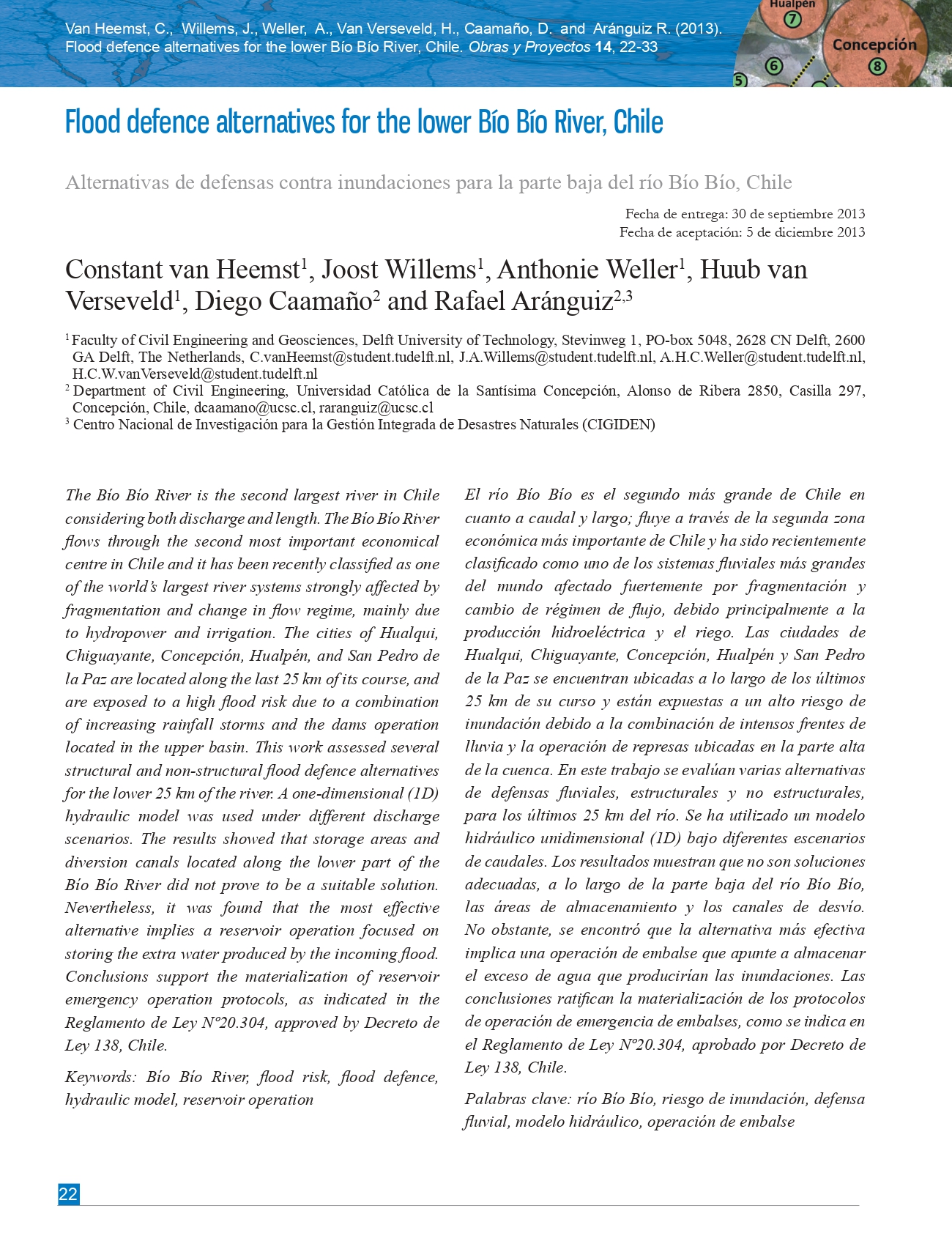Flood defence alternatives for the lower Bío Bío River, Chile
DOI:
https://doi.org/10.4067/S0718-28132013000200002Keywords:
Bío Bío River, flood risk, flood defence, hydraulic model, reservoir operationAbstract
The Bío Bío River is the second largest river in Chile considering both discharge and length. The Bío Bío River flows through the second most important economical centre in Chile and it has been recently classified as one of the world's largest river systems strongly affected by fragmentation and change in flow regime, mainly due to hydropower and irrigation. The cities of Hualqui, Chiguayante, Concepción, Hualpén, and San Pedro de la Paz are located along the last 25 km of its course, and are exposed to a high flood risk due to a combination of increasing rainfall storms and the dams operation located in the upper basin. This work assessed several structural and non-structural flood defence alternatives for the lower 25 km of the river. A one-dimensional (1D) hydraulic model was used under different discharge scenarios. The results showed that storage areas and diversion canals located along the lower part of the Bío Bío River did not prove to be a suitable solution. Nevertheless, it was found that the most effective alternative implies a reservoir operation focused on storing the extra water produced by the incoming flood. Conclusions support the materialization of reservoir emergency operation protocols, as indicated in the Reglamento de Ley N°20.304, approved by Decreto de Ley 138, Chile.
References
Barnes, H. (1967). Roughness Characteristics of Natural Channels. Washington, USGS
Caamaño, D. (2010). Sustainability of morphology features in alluvial rivers and coastal systems in Chile: the Bío Bío River as study case. FONDECYT project N°11100399
Fernández, M. (2013). Cambios morfológicos y efectos en las velocidades y alturas del flujo en la parte bajo del río Bío Bío. Memoria de título de Ingeniero Civil, Universidad Católica de la Santísima Concepción, Chile
García, A., Jorde, K., Habit, E., Caamaño, D. and Parra, O. (2011). Downstream environmental effects of dam operations: changes in habitat quality for native fish species. River Research and Applications 27(3); 312-327. https://doi.org/10.1002/rra.1358
MOP Ministerio de Obras Públicas (2004). Mediciones realizadas en el río Bío Bío. Concepción.
ONEMI (2012). http://www.onemi.cl/
Osorio, R. (2010). Informe eje hidráulico río Bío Bío. Concepción.
Parra, O. (2006). The Bío Bío River basin. Centro EULA, Universidad de Concepción
U.S. Army Corps of Engineers (2010). HEC-RAS, River Analysis System, Hydraulic Reference Manual. Davis, CA.
van Heemst, C., Weller, A.H.C., van Verseveld, H.C.W. and Willems, J.A. (2012). A flood defence strategy for the Greater Concepción. Analysing, modelling and finding engineering solutions for the Bío Bío floods. Master course report, Delft University of Technology and Universidad Católica de la Santísima Concepción

Downloads
Published
Issue
Section
License
Copyright (c) 2013 Universidad Católica de la Santísima Concepción

This work is licensed under a Creative Commons Attribution-NonCommercial 4.0 International License.







